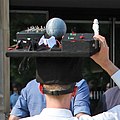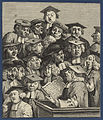Doctoral hat

The Mortar is the former PhD after completing his PhD as an outward sign of the newly acquired doctorate from the Dean the Faculty (in some smaller universities also from the rector presented).
The variant of the mortarboard that is most common today consists of a black cap with a square plate on the top adorned with a tassel . This version also corresponds to the mortarboard from Great Britain (literally: “ mortar board ”), although this is not worn there by doctors, but traditionally in particular by master’s graduates.
Doctoral hats by country and region
Germany
The ceremony for the awarding of the doctoral hat, which used to be customary, has been omitted at most universities, including those in German-speaking countries. At some universities the solemn doctor's oath has remained, with which the doctoral candidate promises to fulfill the obligations associated with the doctorate. However, some German universities (e.g. the University of Bonn ) are now holding graduation ceremonies based on the American model with mortarboards for master's and bachelor's degrees . Before this hat shape was used, a doctoral hat looked different and corresponded more to its British counterpart, as the portrait of Martin Luther with a doctoral hat shows (see below ).
At some Central European universities it is customary to design doctoral hats freely; this is often done by colleagues, fellow students or fellow doctoral students. The self-made doctoral hats then reflect the work or personal characteristics of the doctoral student. For example, a doctoral cap can consist of chocolate or represent a machine part. The doctoral hat is presented after passing the final exam or during a graduation ceremony.
Historical gowns from the Free University of Berlin with German doctoral hats
Freely designed doctoral cap of a Dr. rer. nat. at the Leibniz University Hannover
Doctoral hat for Dr. rer. nat. at the University of Hamburg , Faculty of Psychology and Movement Science
Great Britain

In the United Kingdom , the so-called mortarboards (officially academic cap ) were originally only worn by Master’s graduates, but nowadays they are often worn by Bachelor’s students as well. These are completely black; only the university management wears gold tassels. Doctors, on the other hand, traditionally wear a round beret ( English Tudor bonnet ) similar to a tartan hat . The hats mentioned are worn together with a gown , which is designed differently depending on the academic degree , the color of which mostly corresponds to the colors of the university, but also partly to those of the faculty.
United States
In the USA , mortarboards are worn by graduates of all academic degrees (sometimes even at the end of high school or college ). For undergraduate and graduate students, the color of the tassel (and gown) indicates the faculty; for example, according to an official guideline of the American Council on Education, purple stands for law , green for medicine and red for theology . At high schools it corresponds to the colors of the school, but also partly to the final grade . Doctors wear velvet hats with a gold tassel. In the meantime, round berets such as in Great Britain are also becoming more common among them.
A special feature of some American universities is the special meaning of the position of the tassel: while Bachelor graduates wear it on the right side, after the Master’s degree it is on the left side of the hat. Often this position is therefore solemnly changed by the master's graduates at the graduation ceremony.
In Scandinavia, a special top hat has long been used for graduation celebrations .
In Sweden , the award ceremony with the traditional doctoral hat is still common, provided the graduate is willing to buy the hat they need. One of the few opportunities to wear the doctoral hat is the regular public doctoral degrees ( twice a year at Uppsala University ). In Uppsala, the promoter places a laurel wreath on the forehead of the new doctors in Uppsala, the promoter himself also wears one. In addition, it is customary in Sweden to show your doctorate by wearing a doctor's ring , which, unlike a hat, you can always wear. Depending on the faculty, the ring is adorned with a suitable symbol; thus the doctor's rings of the doctors show the staff of Aesculapia .
Other countries
Awarded a doctorate at the Universidad Complutense de Madrid
Doctors at the Universidad de Cádiz
Director of the Universidad de La Rioja
Doctors of the Sorbonne
history
Academic headgear has its origins in the headgear of church dignitaries and of the 11th and 12th centuries. It became part of the dress code of the educational institutions newly established in those years: Bologna (founded 1088), Paris (1150), Oxford (1167), Modena (1175) and others. The shape, in turn, comes from the soft Pillei (singular: Pileus ), also known as "caps of freedom", as those freed from Rome, i.e. ex-slaves, who covered their freshly shaved heads with them - repeatedly changed in color or shape . Later one began to save material and effort for the cap production out of expediency, to cut simple geometric shapes. The first square structures appeared between 1500 and 1550. At first, Catholic clergy used this new headgear ( biretta ), but it also found its way into universities, where it was mainly only worn by students and teaching staff of theological subjects. All other disciplines ( law , physics and musical subjects) wore the round hat.
At the end of the 17th century, the square hat began to replace the round hat. At Oxford, although the round shape was mandatory for most students, the status of theology students was highly regarded and their square headgear was a symbol of desire among the students of the “low” subjects. In 1675 the first students, at least if they were of aristocratic origin, were allowed to wear the square hat as well. This can be seen as the beginning of the widespread use of the “mortar board” in academic operations, as the hat is jokingly called in English. Now the cap was worn with an approx. 10 cm long silk tassel attached in the middle and hanging over the edge . This is attached to a button that used to hold the fabric panels of the hat together.
While the first doctoral hats were elaborately tailored and equipped, today's models are often industrially manufactured from synthetic fiber, which, due to its elasticity, no longer requires costly changes by tailors to take into account the individual head size. The appearance and design of today's doctoral cap go back to a US patent that was filed in 1950 by the inventor Edward O'Reilly and the Catholic priest Joseph Durham. The idea and the subsequent patent included a. a stiffener made of fiberglass that was sewn into the doctoral cap.
Martin Luther with doctoral cap, by Lucas Cranach the Elder (1521)
Students at a Lecture with Different Hats, by William Hogarth (1736)
John Harvey Kellogg (1914)
See also
Web links
Individual evidence
- Goff, Philip (1999). University of London Academic Dress . London: University of London Press.
- ↑ Laura Hennemann: Physicist Humor: Espresso from the doctoral hat . Spiegel Online from March 13, 2013.
- ↑ Yale Allumni Magazine July-August 2008
- ↑ U.S. Patent No. 2880423












